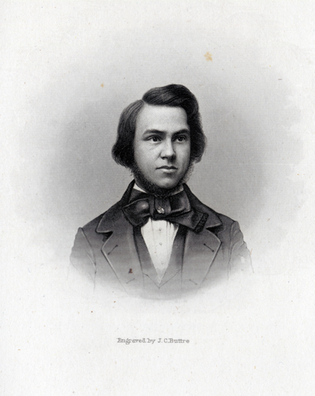 loading
loading
Old YaleThe first Yale Club150 years ago, Cincinnati Yalies decided to meet more often. Judith Ann Schiff is chief research archivist at the Yale University Library.  Manuscripts and ArchivesRobert Brown, Class of 1857—shown here in an engraving from the 1857 class album—was a cofounder of the first-ever formally organized Yale Club, in Cincinnati. View full imageIn 1864, a committee of Yale alumni in Cincinnati founded the first organized Yale club. The preamble of their plan of organization shows how seriously they took the task. Their tripartite mission was
The club owed its existence to the respect the Cincinnati alumni had for pioneering science professor Benjamin Silliman Sr., Class of 1796, who had taught at Yale for half a century. Silliman died on Thanksgiving Day, November 24, 1864. On the 25th, Alphonso Taft ’33, ’67LLD, and Robert Brown ’57 published an anonymous newspaper item calling for all Cincinnati “resident or sojourning graduates of Yale College” to meet in the Masonic Hall the following day to observe Silliman’s passing. The attendees enjoyed the camaraderie and reminiscing so much that they decided on the spot to form a club. The founders included some notable alumni. As an undergraduate, Taft had founded Skull and Bones with William H. Russell ’33. He moved to Cincinnati in 1839 (after informing his father that Vermont was a “noble state to emigrate from”), and there he became a prominent lawyer and judge; he would serve as US secretary of war and US attorney general, and his son, William Howard Taft ’78, would become president. George E. Day ’33 was a professor of biblical literature who later joined the Yale Divinity School faculty. Robert Brown, who had studied comparative anatomy at the Yale medical school, worked in the pork-packing business and then for Cincinnati Gas Light and Coke; in 1882 he would become secretary of the newly organized Yale Observatory and serve there for 25 years. We have a record of one of the club’s early reunion dinners thanks to the Cincinnati Gazette, which published a long article (reprinted in the Yale Courant) about the dinner of April 17, 1867. The article was headlined “YALE IN CINCINNATI—Reunion Supper—Wit, Wisdom & Enthusiasm.” It noted that the party took place at “the hall on the corner of Seventh and Vine Streets” (thus omitting the indecorous name of that hall, Smith’s Saloon). There were 11 formal toasts “augmented by many impromptu ones,” all to enable the participants to “live over the pleasant days of Yale life and drink fresh draughts to Yale enthusiasm.” One toast, used frequently at Yale, was to “the Faculty of Yale—May all their faculties be ever preserved.” Another was to “the Merrie Wives of Yale—Artium Matres—A.M’s. May their tribe increase.” There were also more-serious toasts, to other Yale clubs and to “the Soldiers of Yale.” In his remarks, Judge Isaac C. Collins ’46 “alluded to the failure of many men, brilliant in college, in after life; and expressed his conviction that it was to the great middle class of college that we are chiefly to look for the leaders of popular reform, and for distinguished careers.” The Gazette also noted that, since the founding of the Cincinnati club, Yale alumni in several other cities—New York, Boston, Chicago, and St. Louis among them—had formed their own clubs. “Following the example set in this city,” the writer said, these clubs too would gather “to recall the memories and sing the praises of Alma Mater.”
The comment period has expired.
|
|